2004 MITSUBISHI ENDEAVOR display
[x] Cancel search: displayPage 4 of 3870
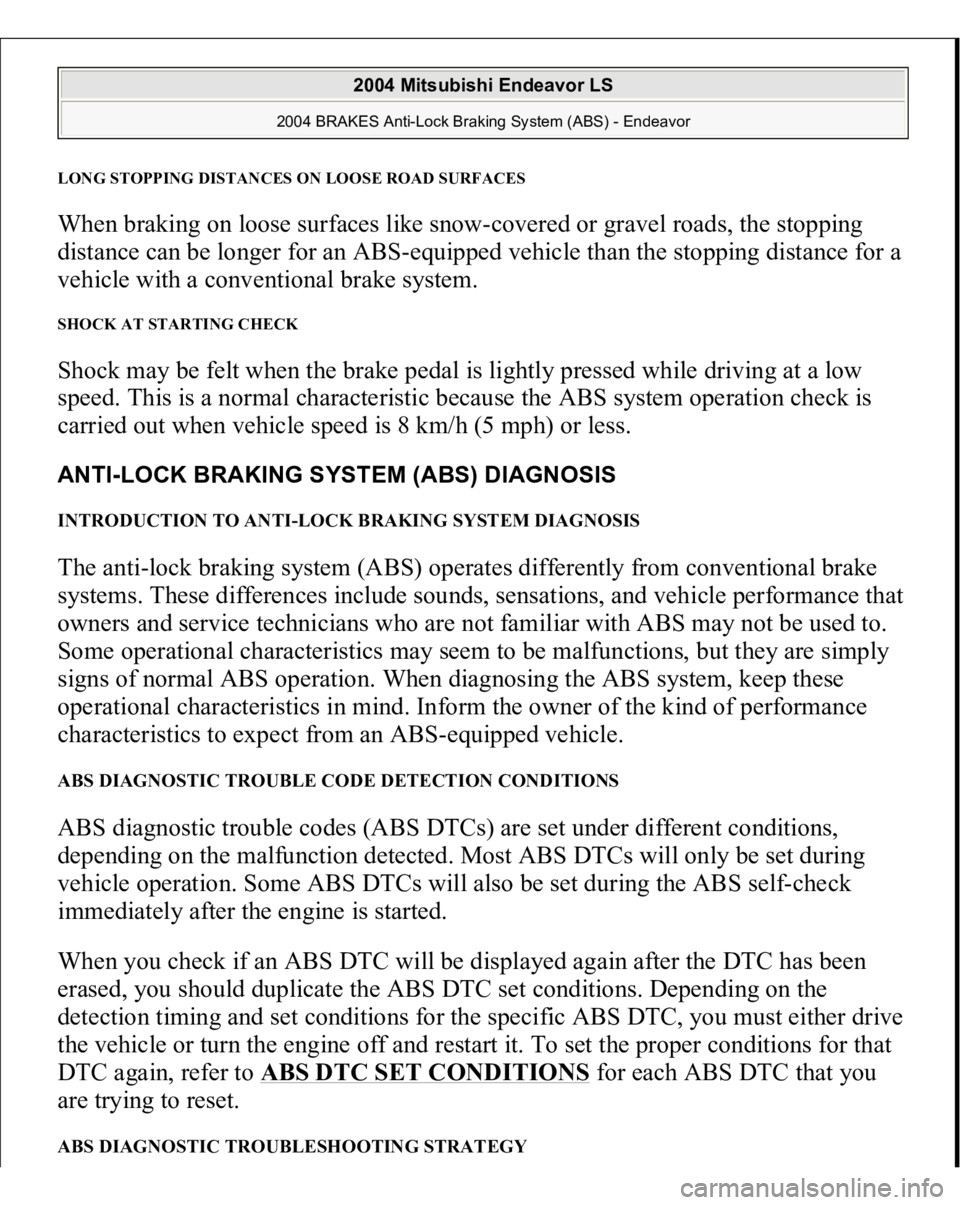
LONG STOPPING DISTANCES ON LOOSE ROAD SURFACESWhen braking on loose surfaces like snow-covered or gravel roads, the stopping
distance can be longer for an ABS-equipped vehicle than the stopping distance for a
vehicle with a conventional brake system. SHOCK AT STARTING CHECK Shock may be felt when the brake pedal is lightly pressed while driving at a low
speed. This is a normal characteristic because the ABS system operation check is
carried out when vehicle speed is 8 km/h (5 mph) or less. ANTI-LOCK BRAKING SYSTEM (ABS) DIAGNOSIS INTRODUCTION TO ANTI-LOCK BRAKING SYSTEM DIAGNOSIS The anti-lock braking system (ABS) operates differently from conventional brake
systems. These differences include sounds, sensations, and vehicle performance that
owners and service technicians who are not familiar with ABS may not be used to.
Some operational characteristics may seem to be malfunctions, but they are simply
signs of normal ABS operation. When diagnosing the ABS system, keep these
operational characteristics in mind. Inform the owner of the kind of performance
characteristics to expect from an ABS-equipped vehicle. ABS DIAGNOSTIC TROUBLE CODE DETECTION CONDITIONS ABS diagnostic trouble codes (ABS DTCs) are set under different conditions,
depending on the malfunction detected. Most ABS DTCs will only be set during
vehicle operation. Some ABS DTCs will also be set during the ABS self-check
immediately after the engine is started.
When you check if an ABS DTC will be displayed again after the DTC has been
erased, you should duplicate the ABS DTC set conditions. Depending on the
detection timing and set conditions for the specific ABS DTC, you must either drive
the vehicle or turn the engine off and restart it. To set the proper conditions for that
DTC again, refer to ABS DTC SET CONDITIONS
for each ABS DTC that you
are trying to reset.
ABS DIAGNOSTIC TROUBLESHOOTING STRATEGY
2004 Mitsubishi Endeavor LS
2004 BRAKES Anti-Lock Braking System (ABS) - Endeavor
Page 8 of 3870
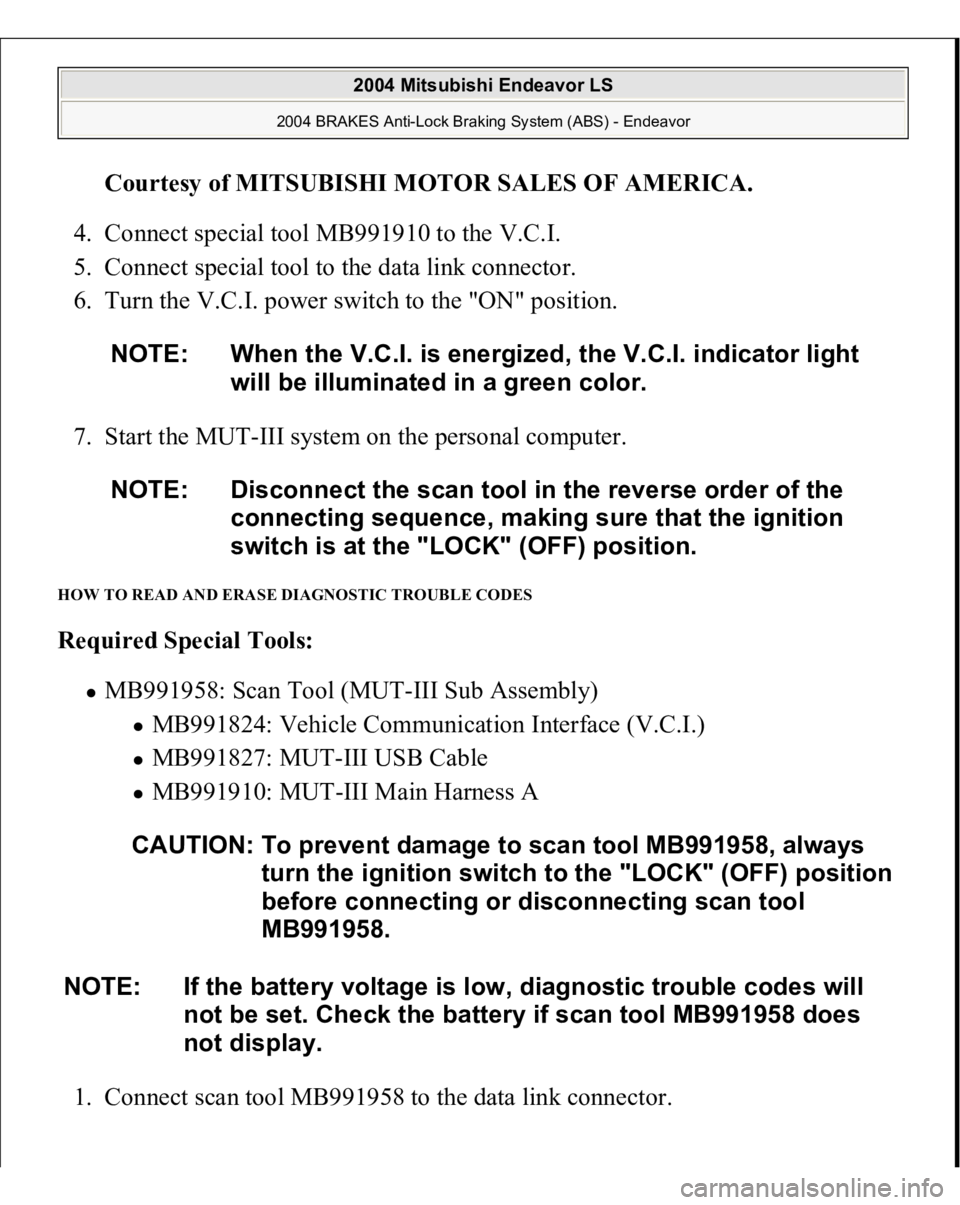
Courtesy of MITSUBISHI MOTOR SALES OF AMERICA
.
4. Connect special tool MB991910 to the V.C.I.
5. Connect special tool to the data link connector.
6. Turn the V.C.I. power switch to the "ON" position.
7. Start the MUT-III system on the personal computer.
HOW TO READ AND ERASE DIAGNOSTIC TROUBLE CODES Required Special Tools:
MB991958: Scan Tool (MUT-III Sub Assembly)
MB991824: Vehicle Communication Interface (V.C.I.) MB991827: MUT-III USB Cable MB991910: MUT-III Main Harness A
1. Connect scan tool MB991958 to the data link connec
tor. NOTE: When the V.C.I. is energized, the V.C.I. indicator light
will be illuminated in a green color.
NOTE: Disconnect the scan tool in the reverse order of the
connecting sequence, making sure that the ignition
switch is at the "LOCK" (OFF) position.
CAUTION: To prevent damage to scan tool MB991958, always
turn the ignition switch to the "LOCK" (OFF) position
before connecting or disconnecting scan tool
MB991958.
NOTE: If the battery voltage is low, diagnostic trouble codes will
not be set. Check the battery if scan tool MB991958 does
not display.
2004 Mitsubishi Endeavor LS
2004 BRAKES Anti-Lock Braking System (ABS) - Endeavor
Page 14 of 3870
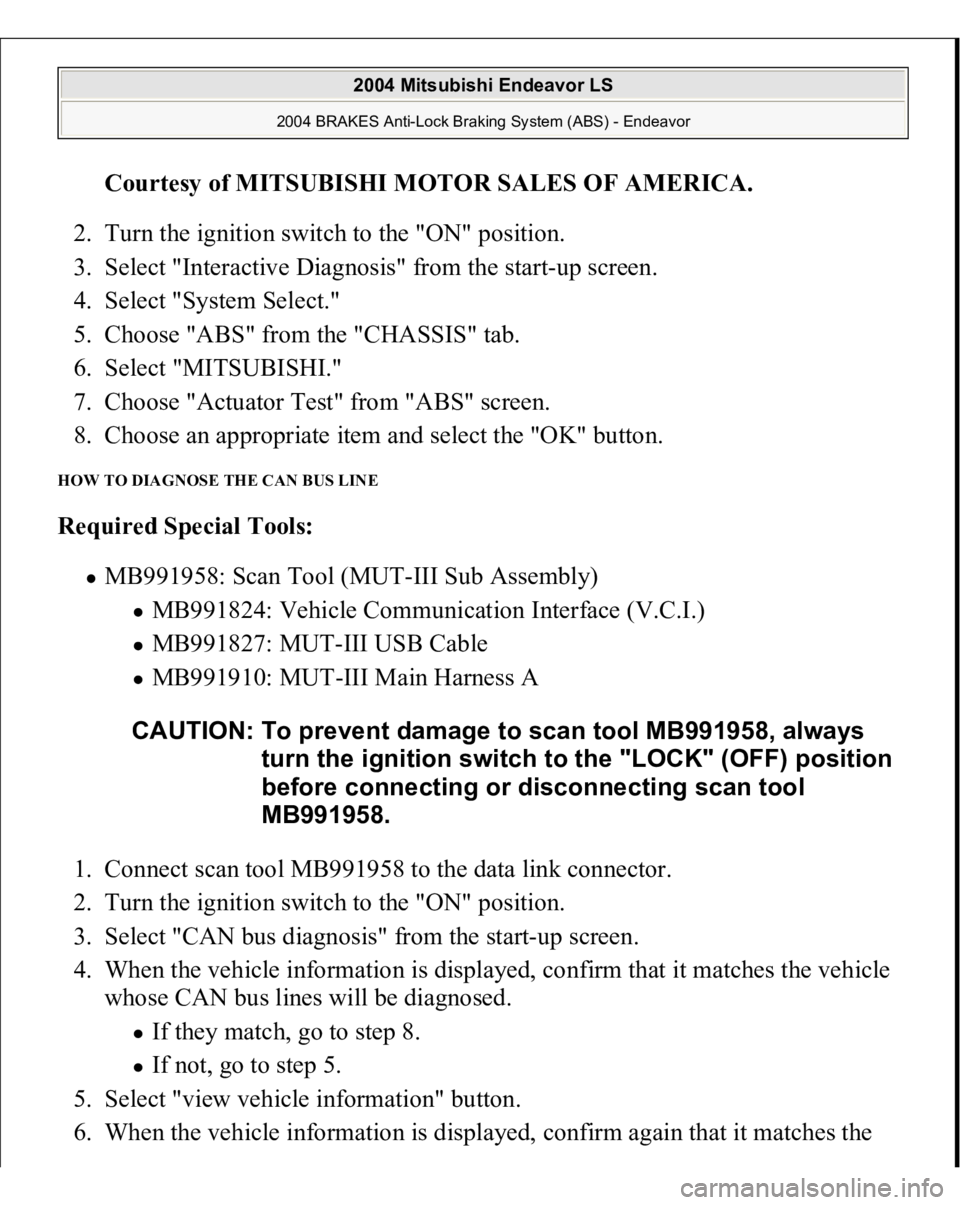
Courtesy of MITSUBISHI MOTOR SALES OF AMERICA
.
2. Turn the ignition switch to the "ON" position.
3. Select "Interactive Diagnosis" from the start-up screen.
4. Select "System Select."
5. Choose "ABS" from the "CHASSIS" tab.
6. Select "MITSUBISHI."
7. Choose "Actuator Test" from "ABS" screen.
8. Choose an appropriate item and select the "OK" button.
HOW TO DIAGNOSE THE CAN BUS LINE Required Special Tools:
MB991958: Scan Tool (MUT-III Sub Assembly)
MB991824: Vehicle Communication Interface (V.C.I.) MB991827: MUT-III USB Cable MB991910: MUT-III Main Harness A
1. Connect scan tool MB991958 to the data link connector.
2. Turn the ignition switch to the "ON" position.
3. Select "CAN bus diagnosis" from the start-up screen.
4. When the vehicle information is displayed, confirm that it matches the vehicle
whose CAN bus lines will be diagnosed. If they match, go to step 8. If not, go to step 5.
5. Select "view vehicle information" button.
6. When the vehicle information is dis
played, confirm a
gain that it matches the CAUTION: To prevent damage to scan tool MB991958, always
turn the ignition switch to the "LOCK" (OFF) position
before connecting or disconnecting scan tool
MB991958.
2004 Mitsubishi Endeavor LS
2004 BRAKES Anti-Lock Braking System (ABS) - Endeavor
Page 15 of 3870
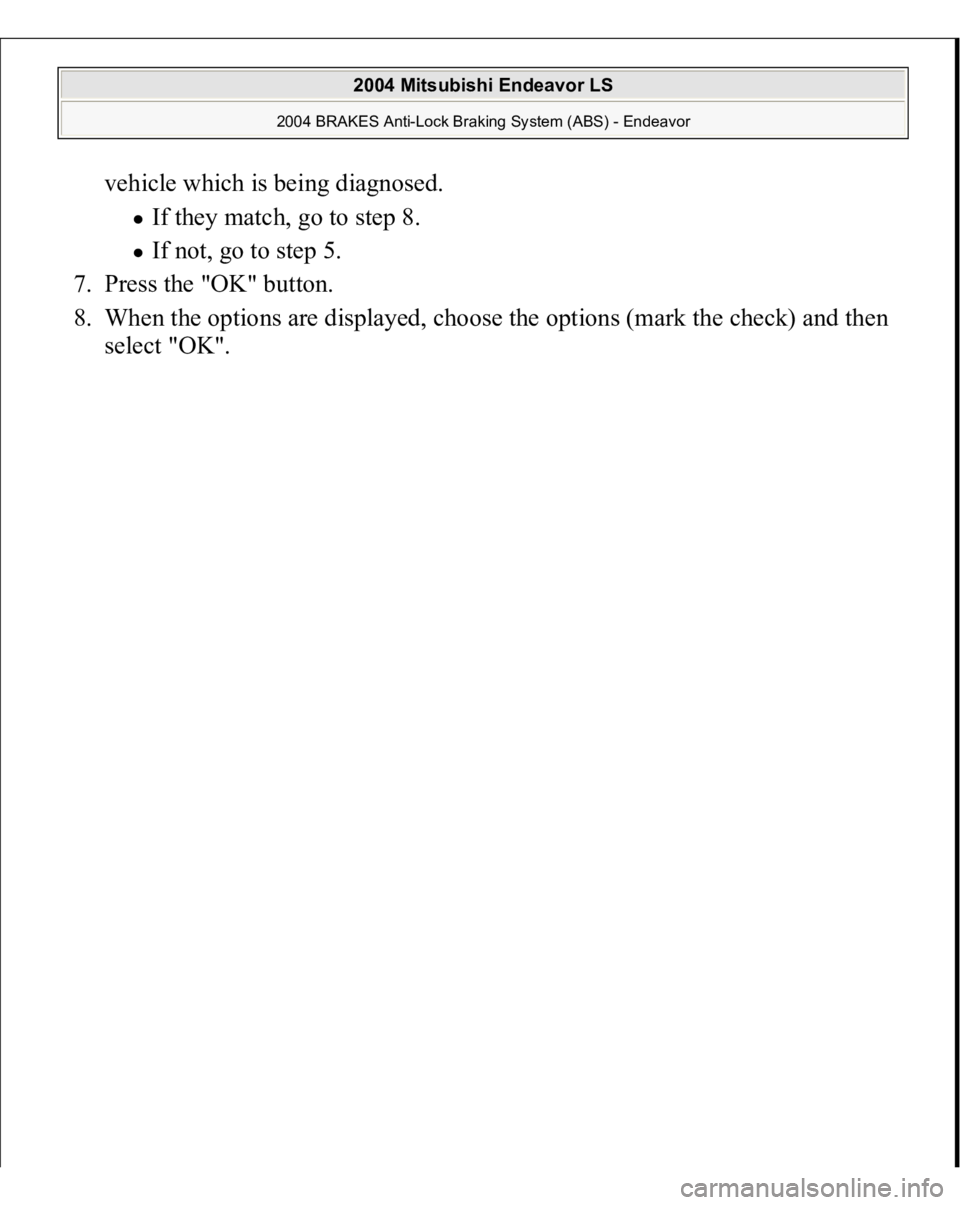
vehicle which is being diagnosed.
If they match, go to step 8. If not, go to step 5.
7. Press the "OK" button.
8. When the options are displayed, choose the options (mark the check) and then
select "OK".
2004 Mitsubishi Endeavor LS
2004 BRAKES Anti-Lock Braking System (ABS) - Endeavor
Page 237 of 3870
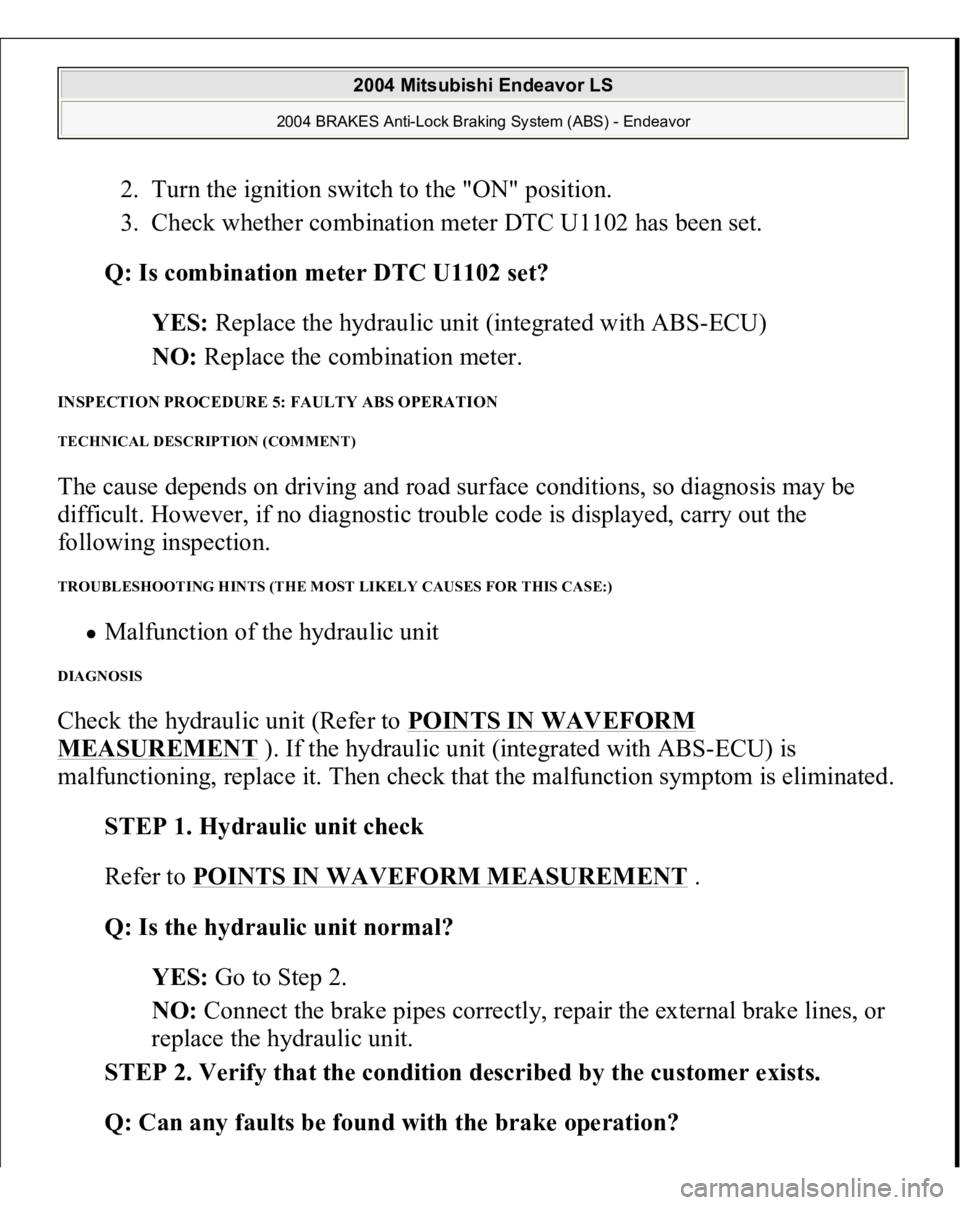
2. Turn the ignition switch to the "ON" position.
3. Check whether combination meter DTC U1102 has been set.
Q: Is combination meter DTC U1102 set?
YES: Replace the hydraulic unit (integrated with ABS-ECU)
NO: Replace the combination meter.
INSPECTION PROCEDURE 5: FAULTY ABS OPERATION TECHNICAL DESCRIPTION (COMMENT) The cause depends on driving and road surface conditions, so diagnosis may be
difficult. However, if no diagnostic trouble code is displayed, carry out the
following inspection. TROUBLESHOOTING HINTS (THE MOST LIKELY CAUSES FOR THIS CASE:)
Malfunction of the hydraulic unit
DIAGNOSIS Check the hydraulic unit (Refer to POINTS IN WAVEFORM MEASUREMENT
). If the hydraulic unit (integrated with ABS-ECU) is
malfunctioning, replace it. Then check that the malfunction symptom is eliminated.
STEP 1. Hydraulic unit check
Refer to POINTS IN WAVEFORM MEASUREMENT
.
Q: Is the hydraulic unit normal?
YES: Go to Step 2.
NO: Connect the brake pipes correctly, repair the external brake lines, or
replace the hydraulic unit.
STEP 2. Verify that the condition described by the customer exists.
Q: Can any faults be found with the brake operation?
2004 Mitsubishi Endeavor LS
2004 BRAKES Anti-Lock Braking System (ABS) - Endeavor
Page 287 of 3870
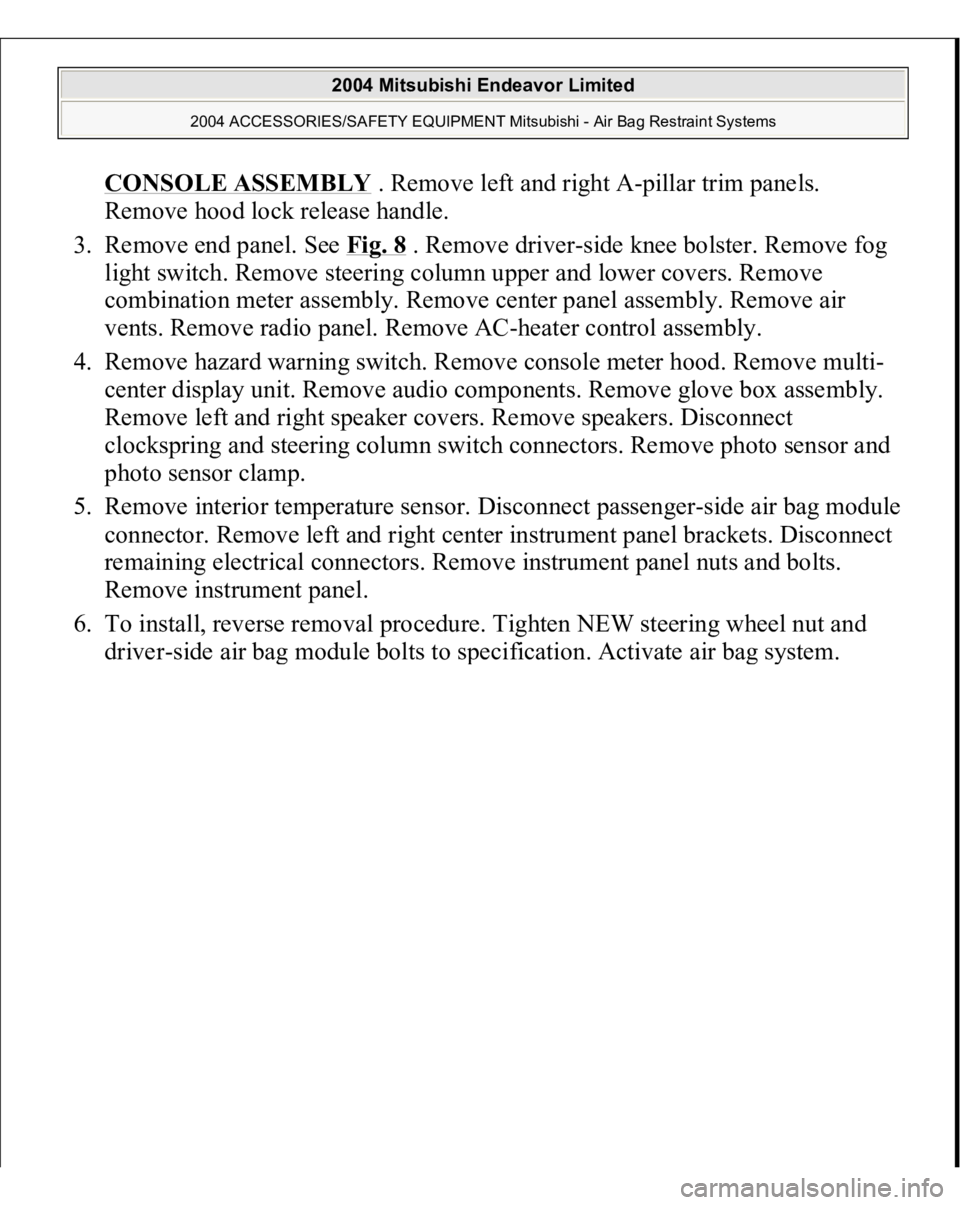
CONSOLE ASSEMBL
Y . Remove left and right A-pillar trim panels.
Remove hood lock release handle.
3. Remove end panel. See Fig. 8
. Remove driver-side knee bolster. Remove fog
light switch. Remove steering column upper and lower covers. Remove
combination meter assembly. Remove center panel assembly. Remove air
vents. Remove radio panel. Remove AC-heater control assembly.
4. Remove hazard warning switch. Remove console meter hood. Remove multi-
center display unit. Remove audio components. Remove glove box assembly.
Remove left and right speaker covers. Remove speakers. Disconnect
clockspring and steering column switch connectors. Remove photo sensor and
photo sensor clamp.
5. Remove interior temperature sensor. Disconnect passenger-side air bag module
connector. Remove left and right center instrument panel brackets. Disconnect
remaining electrical connectors. Remove instrument panel nuts and bolts.
Remove instrument panel.
6. To install, reverse removal procedure. Tighten NEW steering wheel nut and
drive
r-side air ba
g module bolts to s
pecification. Activate air ba
g system.
2004 Mitsubishi Endeavor Limited
2004 ACCESSORIES/SAFETY EQUIPMENT Mitsubishi - Air Bag Restraint Systems
Page 300 of 3870
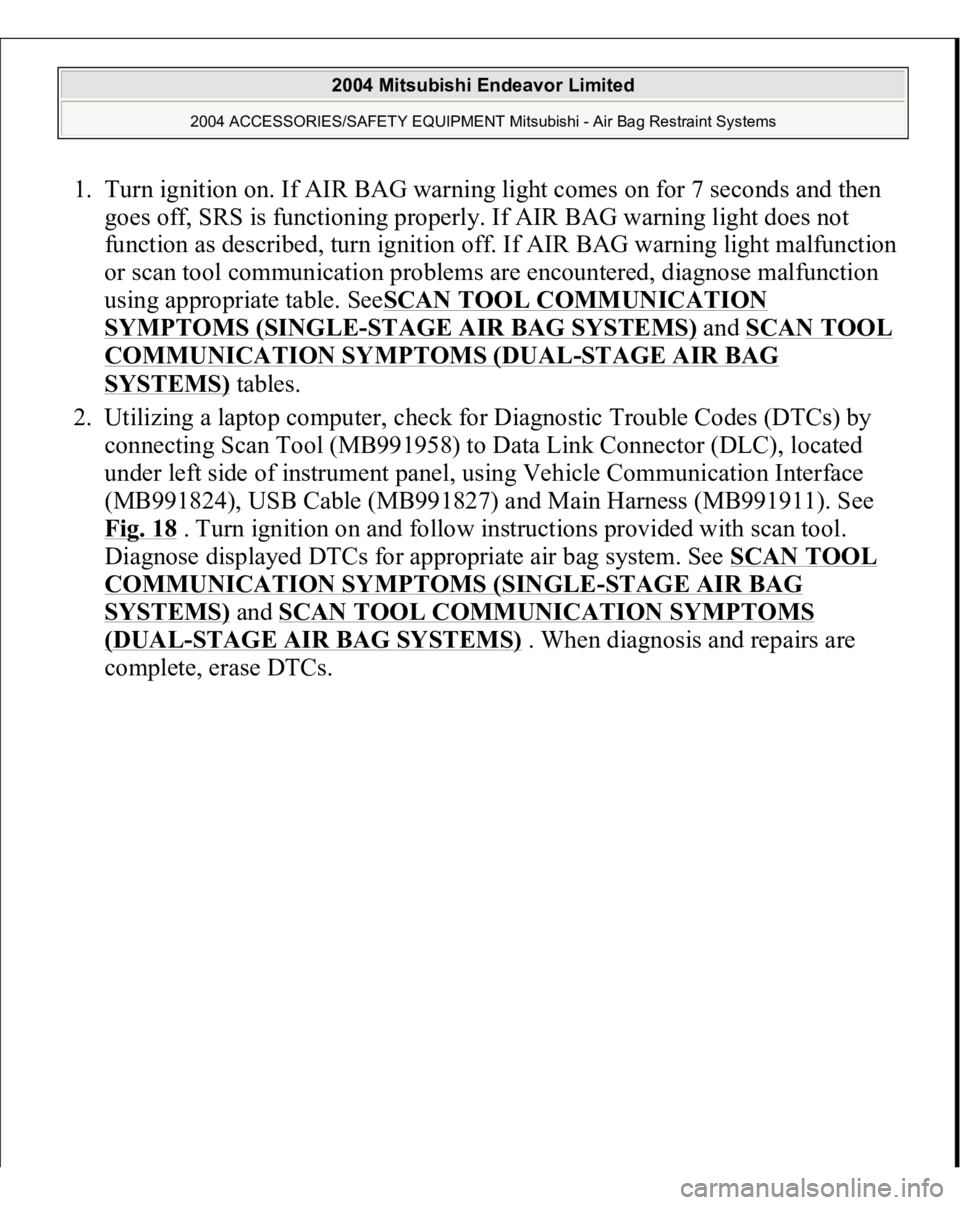
1. Turn ignition on. If AIR BAG warning light comes on for 7 seconds and then
goes off, SRS is functioning properly. If AIR BAG warning light does not
function as described, turn ignition off. If AIR BAG warning light malfunction
or scan tool communication problems are encountered, diagnose malfunction
using appropriate table. SeeSCAN TOOL COMMUNICATION
SYMPTOMS (SINGLE
-STAGE AIR BAG SYSTEMS)
and SCAN TOOL
COMMUNICATION SYMPTOMS (DUAL
-STAGE AIR BAG
SYSTEMS)
tables.
2. Utilizing a laptop computer, check for Diagnostic Trouble Codes (DTCs) by
connecting Scan Tool (MB991958) to Data Link Connector (DLC), located
under left side of instrument panel, using Vehicle Communication Interface
(MB991824), USB Cable (MB991827) and Main Harness (MB991911). See
Fig. 18
. Turn ignition on and follow instructions provided with scan tool.
Diagnose displayed DTCs for appropriate air bag system. See SCAN TOOL
COMMUNICATION SYMPTOMS (SINGLE
-STAGE AIR BAG
SYSTEMS)
and SCAN TOOL COMMUNICATION SYMPTOMS
(DUAL
-STAGE AIR BAG SYSTEMS)
. When diagnosis and repairs are
com
plete, erase DTCs.
2004 Mitsubishi Endeavor Limited
2004 ACCESSORIES/SAFETY EQUIPMENT Mitsubishi - Air Bag Restraint Systems
Page 445 of 3870
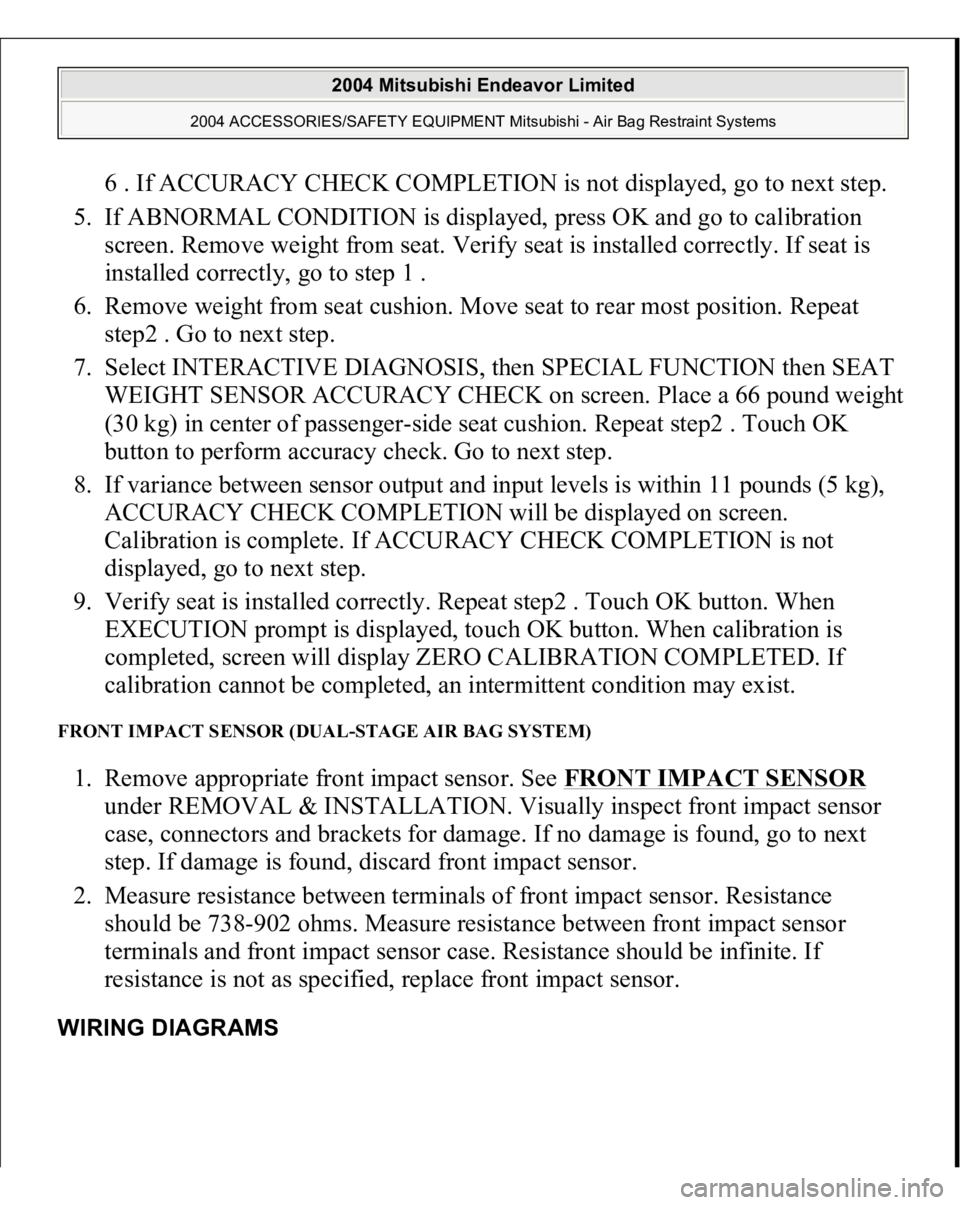
6 . If ACCURACY CHECK COMPLETION is not displayed, go to next step.
5. If ABNORMAL CONDITION is displayed, press OK and go to calibration
screen. Remove weight from seat. Verify seat is installed correctly. If seat is
installed correctly, go to step 1 .
6. Remove weight from seat cushion. Move seat to rear most position. Repeat
step2 . Go to next step.
7. Select INTERACTIVE DIAGNOSIS, then SPECIAL FUNCTION then SEAT
WEIGHT SENSOR ACCURACY CHECK on screen. Place a 66 pound weight
(30 kg) in center of passenger-side seat cushion. Repeat step2 . Touch OK
button to perform accuracy check. Go to next step.
8. If variance between sensor output and input levels is within 11 pounds (5 kg),
ACCURACY CHECK COMPLETION will be displayed on screen.
Calibration is complete. If ACCURACY CHECK COMPLETION is not
displayed, go to next step.
9. Verify seat is installed correctly. Repeat step2 . Touch OK button. When
EXECUTION prompt is displayed, touch OK button. When calibration is
completed, screen will display ZERO CALIBRATION COMPLETED. If
calibration cannot be completed, an intermittent condition may exist.
FRONT IMPACT SENSOR (DUAL-STAGE AIR BAG SYSTEM) 1. Remove appropriate front impact sensor. See FRONT IMPACT SENSOR
under REMOVAL & INSTALLATION. Visually inspect front impact sensor
case, connectors and brackets for damage. If no damage is found, go to next
step. If damage is found, discard front impact sensor.
2. Measure resistance between terminals of front impact sensor. Resistance
should be 738-902 ohms. Measure resistance between front impact sensor
terminals and front impact sensor case. Resistance should be infinite. If
resistance is not as specified, replace front impact sensor.
WIRING DIAGRAMS
2004 Mitsubishi Endeavor Limited
2004 ACCESSORIES/SAFETY EQUIPMENT Mitsubishi - Air Bag Restraint Systems